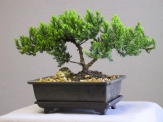For centuries, people the world over have been fascinated by bonsai (pronounced BONE- SIGH). These carefully trained trees and shrubs captivate the imagination, as they seem to be impossibly old for their small size, all the while appearing to be exact, miniaturized replicas of mature, full-sized specimens.
The term bonsai’ is a Japanese word made up of two characters: bon’, meaning tray, container, or pot, and sai’, which means tree or planted tree. Thus, bonsai’ may be best translated as “tree planted in a tray’ (to say “bonsai tree” is redundant). The word is both singular and plural, and though they occur in a variety of sizes and shapes, bonsai are always in pots. The practice of growing bonsai originated in China thousands of years ago, but has been truly perfected by Japanese masters.
A typical bonsai is usually a deciduous or evergreen tree which has been maintained at a size between ten and thirty inches tall, although smaller and larger sizes are common. These trees are carefully pruned, trained, potted and coddled so as to maintain their dwarfed size despite ever-increasing age. Age, of course, adds character…an aesthetic quality which bonsai enthusiasts strive for. The older a tree is, the better. There are bonsai specimens living today which are literally hundreds of years old…trees which have been handed down from generation to generation, or which have adorned the entrances to temples or palaces, or which have been official gifts to heads of state. Some bonsai have been trained to resemble ancient and nearly- dead evergreen trees, weathered and beaten by the elements while clinging to a windy cliff. Others are planted in groups which call to mind the stately serenity of a primaeval forest. A solitary, gnarled and statuesque tree may seem to hold the history and the wisdom of the ages.
 Bonsai care depends on what species the plant is. Traditionally, bonsai have been created of trees from temperate climate zones, like Japan, with a regular cycle of changing seasons. Various species of pine, spruce, and small-leaved elms and maples are typical. Caring for these trees requires growing them out of doors and duplicating their native environment. Because they are normally planted in relatively small or shallow containers, good care requires frequent watering (sometimes several times a day) during the growing season. In the wintertime, these bonsai are frequently placed in a cold frame to protect them from drying winds and extreme temperatures while providing a necessary and chilly dormancy. These plants should never be kept indoors for very long periods of time.
Bonsai care depends on what species the plant is. Traditionally, bonsai have been created of trees from temperate climate zones, like Japan, with a regular cycle of changing seasons. Various species of pine, spruce, and small-leaved elms and maples are typical. Caring for these trees requires growing them out of doors and duplicating their native environment. Because they are normally planted in relatively small or shallow containers, good care requires frequent watering (sometimes several times a day) during the growing season. In the wintertime, these bonsai are frequently placed in a cold frame to protect them from drying winds and extreme temperatures while providing a necessary and chilly dormancy. These plants should never be kept indoors for very long periods of time.
Many tropical and subtropical plants, including some common houseplants, lend themselves to being good bonsai subjects as well. Popular varieties include ficus and pomegranate, among others. These trees require the normal care for their species, keeping them warm and well-watered virtually the year round. In all cases, frequent pruning and shaping is necessary to maintain the shape and character of the plant. Because bonsai are often grown in shallow pots or trays, regular re-potting and root pruning is essential as the plants deplete the nutritive value of the potting soil.
With proper care, bonsai can live for generations, just as any normal size tree. They can become like members of the family. There is a spectacular collection of bonsai specimens at the National Arboretum in Washington, DC, which is well worth a visit. Your professional florist may be able to source some kinds of bonsai for you, but it’s probably more useful to consult a nursery which specializes in such plants. Local bonsai clubs may be located through your area botanical garden, and they typically sponsor shows where bonsai may be viewed or purchased.
Take some time to experience the beautiful art of bonsai.


 Find Your
Find Your 


Speak Your Mind